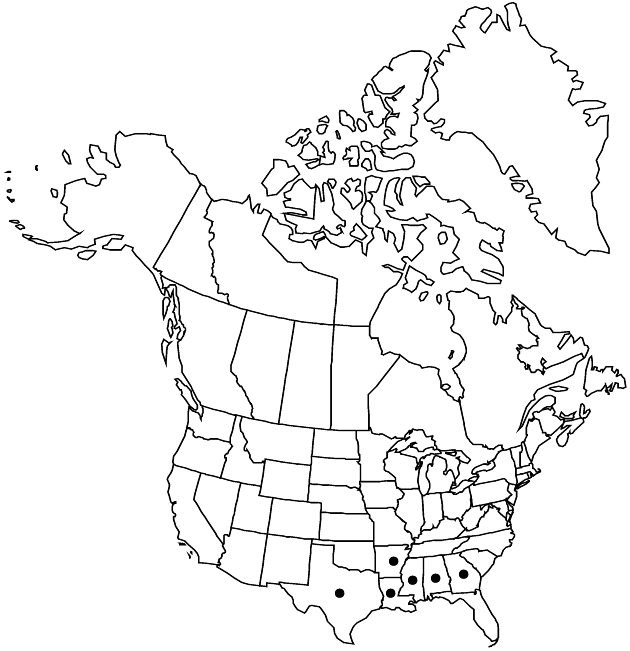Difference between revisions of "Symphyotrichum laeve var. purpuratum"
Phytologia 77: 284. 1995.
FNA>Volume Importer |
FNA>Volume Importer |
||
| Line 7: | Line 7: | ||
|year=1995 | |year=1995 | ||
}} | }} | ||
| − | |basionyms={{Treatment/ID/ | + | |basionyms={{Treatment/ID/Basionym |
|name=Aster purpuratus | |name=Aster purpuratus | ||
|authority=Nees | |authority=Nees | ||
| + | |publication_title=Gen. Sp. Aster., | ||
| + | |publication_place=118. 1832 | ||
}} | }} | ||
|synonyms={{Treatment/ID/Synonym | |synonyms={{Treatment/ID/Synonym | ||
| Line 35: | Line 37: | ||
|elevation=20–100+ m | |elevation=20–100+ m | ||
|distribution=Ala.;Ark.;Ga.;La.;Miss.;Tex. | |distribution=Ala.;Ark.;Ga.;La.;Miss.;Tex. | ||
| − | |discussion=<p>The range of <i></i>var.<i> purpuratum</i> is more southern and western (Gulf Coastal Plains) than that of <i></i>var.<i> concinnum</i> (mainly eastern Appalachians and Piedmont). Controversy surrounds the question of proper rank for this taxon. Semple suggests the rank of species. It is sometimes difficult to distinguish this variety from <i></i>var.<i> concinnum</i>, from which it differs by its mostly basal leaves, basal and proximal leaves persistent and more linear, and often more compact arrays (A. Cronquist 1980). When subspecies are recognized under <i>Symphyotrichum laeve</i>, it is uncertain whether var. attenuatum would constitute a separate subspecies or be part of <i></i>subsp.<i> concinnum</i>.</p> | + | |discussion=<p>The range of <i></i></i>var.<i><i> purpuratum</i> is more southern and western (Gulf Coastal Plains) than that of <i></i></i>var.<i><i> concinnum</i> (mainly eastern Appalachians and Piedmont). Controversy surrounds the question of proper rank for this taxon. Semple suggests the rank of species. It is sometimes difficult to distinguish this variety from <i></i></i>var.<i><i> concinnum</i>, from which it differs by its mostly basal leaves, basal and proximal leaves persistent and more linear, and often more compact arrays (A. Cronquist 1980). When subspecies are recognized under <i>Symphyotrichum laeve</i>, it is uncertain whether var. attenuatum would constitute a separate subspecies or be part of <i></i></i>subsp.<i><i> concinnum</i>.</p> |
|tables= | |tables= | ||
|references= | |references= | ||
| Line 59: | Line 61: | ||
|publication year=1995 | |publication year=1995 | ||
|special status= | |special status= | ||
| − | |source xml=https://jpend@bitbucket.org/aafc-mbb/fna-data-curation.git/src/ | + | |source xml=https://jpend@bitbucket.org/aafc-mbb/fna-data-curation.git/src/f6b125a955440c0872999024f038d74684f65921/coarse_grained_fna_xml/V19-20-21/V20_1137.xml |
|tribe=Asteraceae tribe Astereae | |tribe=Asteraceae tribe Astereae | ||
|genus=Symphyotrichum | |genus=Symphyotrichum | ||
Revision as of 18:40, 24 September 2019
Leaves mostly basal and proximal at flowering (cauline usually reduced), mostly linear, slightly auriculate-clasping, often more than 5 times as long as wide. Phyllaries strongly unequal, apical green zones diamond-shaped. 2n = 48.
Phenology: Flowering Sep–Oct.
Habitat: Dry, open places, prairies, open deciduous woods, mostly on coastal plains
Elevation: 20–100+ m
Distribution

Ala., Ark., Ga., La., Miss., Tex.
Discussion
The range of var. purpuratum is more southern and western (Gulf Coastal Plains) than that of var. concinnum (mainly eastern Appalachians and Piedmont). Controversy surrounds the question of proper rank for this taxon. Semple suggests the rank of species. It is sometimes difficult to distinguish this variety from var. concinnum, from which it differs by its mostly basal leaves, basal and proximal leaves persistent and more linear, and often more compact arrays (A. Cronquist 1980). When subspecies are recognized under Symphyotrichum laeve, it is uncertain whether var. attenuatum would constitute a separate subspecies or be part of subsp. concinnum.
Selected References
None.